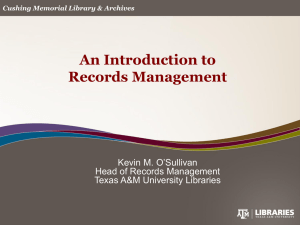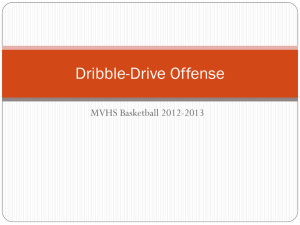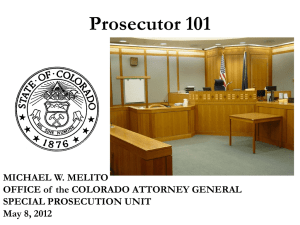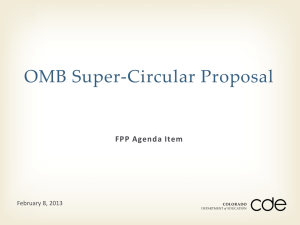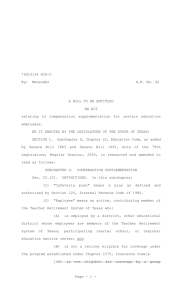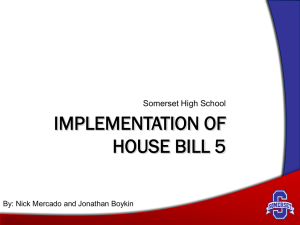Texas Criminal Procedures - PP
advertisement
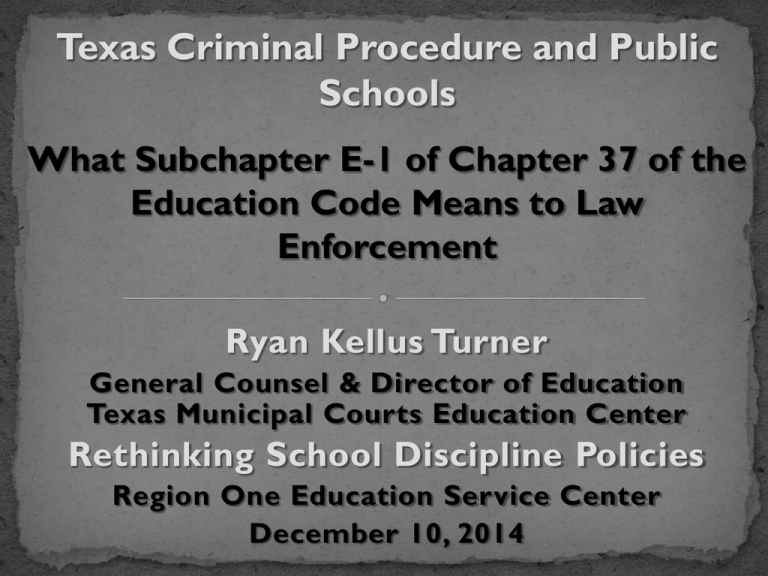
Texas Criminal Procedure and Public Schools What Subchapter E-1 of Chapter 37 of the Education Code Means to Law Enforcement Ryan Kellus Turner General Counsel & Director of Education Texas Municipal Courts Education Center Rethinking School Discipline Policies Region One Education Service Center December 10, 2014 By the end of this presentation, participants will be able to: 1. Describe how “passing the paddle” prompted legislative changes in 2013; 2. Explain the application of Subchapter E-1 of Chapter 37 of the Education Code; 3. Describe how the charging requirements for Subchapter E-1 of Chapter 37 of the Education Code vary from other Class C misdemeanors; 4. Identify ways that cases can be diverted from court without formal adjudication; and, ORGINS (WHY THE LAW CHANGED) A Euphemism Used to Described the Transfer of Discipline of School Age Children (Ages 1016) from Texas Public Schools to Texas Criminal Courts (i.e., Municipal and Justice Courts) Juvenile Court (Civil) Right to Appointed Counsel Statutory Diversion from Court / Prosecutor Review No Fines Records Confidential Municipal and Justice Courts (Criminal) No Right to Appointed Counsel No Diversions (Child Must Appear in Open Court) No Prosecutor Review Fines and Court Costs Conditional Confidentiality Is there a Difference Between the “School to Prison Pipeline” and the “School to Court Pipeline”? 156,263 29,370 Class C Delinquent Misdemeanor Conduct 887 CINS EXCLUDING: Juvenile Traffic – 118,037 Cases DUI of Alcohol - 2,185 Cases ALL JP JUVENILES FILINGS!!!!!!!!! 226 Cert. Felony Criminal Civil 2,400 2,200 2,000 1,800 1,600 Axis Title 1,400 1,200 Total Adjudicated CINS 1,000 800 600 400 200 0 2006 2007 2008 2009 2010 Axis Title 2011 2012 2013 1. Stop Outsourcing School Discipline to Courts. 2. Reduces Related Costs Being Imposed on Local Governments, Tax Payers, Children, and their Families 3. Be“Smart on Crime” while Keeping Texas Public Schools Safe. 4. Provide Pros. & Judges Info & Tools Essential for the Fair Administration of Justice. SB 393 SB 1114 The Charts: 1. Comparison of Former Law to Current S.B. 393 and Other Bills From the 83 rd Regular Legislature 2. OCA School Offenses (Revised) Getting to Know Subchapter E-1 of Chapter 37 of the Education Code: Criminal Procedure In this subchapter: (1) "Child" has the meaning assigned by Article 45.058(h), Code of Criminal Procedure, except that the person must also be a student. (2) "School offense" means an offense committed by a child enrolled in a public school that is a Class C misdemeanor other than a traffic offense and that is committed on property under the control and jurisdiction of a school district. Getting to Know Subchapter E-1 of Chapter 37 of the Education Code: Criminal Procedure CHARGING To the extent of any conflict, this subchapter controls over any other law applied to a school offense alleged to have been committed by a child. (a) A peace officer may not issue a citation to a child who is alleged to have committed a school offense. (b) This subchapter does not prohibit a child from being taken into custody under Section 52.01, Family Code. 1. “School Officers can No Longer Issue on Campus-Citations” headline Texas Tribune, August 29, 2013 2. E-1 prohibits children from being charged with non-traffic Class C misdemeanors in criminal court 3. E-1 prohibits a peace officer from taking a child who is a student at a public school into custody pursuant to the law of arrest and initiating juvenile proceedings against the child under Title 3 of the Family Code 4. E-1 prohibits a peace officer from taking a child who is a student at a public school into custody pursuant to the law of arrest and initiating criminal proceedings in court 5. E-1 does not prohibit a 17 or 18 year old public school student from being issued a citation for a Class C misdemeanor on school grounds (a) A complaint alleging the commission of a school offense must, in addition to the requirements imposed by Article 45.019, Code of Criminal Procedure: (1) be sworn to by a person who has personal knowledge of the underlying facts giving rise to probable cause to believe that an offense has been committed; and (2) be accompanied by a statement from a school employee stating: (A) whether the child is eligible for or receives special services under Subchapter A, Chapter 29; and (B) the graduated sanctions, if required under Section 37.144, that were imposed on the child before the complaint was filed. In other words: A complaint must: (a) Comply with Art. 45.019, CCP (1) PLUS – Have a Personal Knowledge Affiant (2)(A) PLUS – Have a Special Education Declaration (2)(B) PLUS – And MAY require a Graduated Sanctions Declaration (If Applicable) (If Required) Generally, complaints alleging Class C misdemeanors DO NOT have to be sworn to by individuals with personal knowledge. Naff v. State, 946 S.W.2d 529 (Tex. App. Fort Worth 1997); Martin v. State, 13 S.W.3d 133 (Tex. App. Dallas 2000) 1. Can a school peace officer swear to a complaint for a teacher who observed an offense in her classroom? 2. What if there are no witnesses to a criminal mischief at school? Only a peace officer’s investigation. 3. Who can administer the oath for the complaint? Can the peace officer administer the oath to a school employee or student who has personal knowledge. 4. What if a student is assaulted at school and tells his parents. The parent comes to court wanting to file a complaint. Does Sec. 37.146(a)(1) apply? 1. Are they a mandatory component in an E-1 complaint regardless of the offense? 2. Do they apply if my public schools only have a school resource officer (i.e., my public school district does not employ its own school district peace officers)? 3. Does the graduated sanctions requirement in the E-1 complaint process apply if my ISD commissions its own peace officers? 1. The Individual Disability Education Act 2. Manifestation of Disability as Limitation on School to Imposed Punishment 3. Relevance to Prosecutors and Judges in Terms of Determining Culpability and Blameworthiness (b) After a complaint has been filed under this subchapter, a summons may be issued under Articles 23.04 and 45.057(e), Code of Criminal Procedure. An attorney representing the state in a court with jurisdiction may adopt rules pertaining to the filing of a complaint under this subchapter that the state considers necessary in order to: (1) determine whether there is probable cause to believe that the child committed the alleged offense; (2) review the circumstances and allegations in the complaint for legal sufficiency; and (3) see that justice is done. 1. Can an E-1 case result in a summons without a prosecutor’s motion? 2. What is the judge’s roll in the summons's process? 3. “My city is not willing to pay for our city attorney to review complaints.” DIVERSIONS 1. Disposition Without Referral (Sec. 52.03, Family Code) Permissive expansion to include non-traffic Class C misdemeanors 2. First Offender Program (Section 52.031, Family Code) Permissive expansion to include non-traffic Class C misdemeanors 3. School District Peace Officers are Authorized After taking a Child into Custody to Dispose of Cases in Accord with Sec. 52.03 and Sec. 52.031, Family Code 4. Permissive Expansion is Contingent on Approval by the Juvenile Board of each County 1. Juvenile Case Managers (Art. 45.056) • Expanded to Provide Prevention Services for “At Risk Youth” (Art. 45.056(c)(1)(A)) • Intervention Services for Misconduct Prior to Cases Being Filed (Art. 45.056(c)(1)(B)) • Priority for JCM services shall be given to matters “brought under” laws relating to failure to attend school and parent contributing to non-attendance (Art. 45.056(e)) (S.B. 209 from 2011 back from the dead?) Thank You For Your Attention E—MAIL: RTURNER@TMCEC.COM TWITTER: @RKELLUSTURNER


